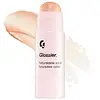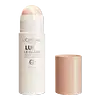What's inside
What's inside
 Key Ingredients
Key Ingredients

 Benefits
Benefits

 Concerns
Concerns

 Ingredients Side-by-side
Ingredients Side-by-side

Pentaerythrityl Tetraisostearate
EmollientOctyldodecanol
EmollientPolybutene
Diisostearyl Malate
EmollientSynthetic Wax
AbrasiveSqualane
EmollientBis-Diglyceryl Polyacyladipate-2
EmollientVp/Hexadecene Copolymer
Sodium Hyaluronate
HumectantTocopheryl Acetate
AntioxidantCrithmum Maritimum Extract
Skin ConditioningUndaria Pinnatifida Extract
Skin ConditioningCaprylic/Capric Triglyceride
MaskingRicinus Communis Seed Oil
MaskingHydrogenated Castor Oil
EmollientPentaerythrityl Tetra-Di-T-Butyl Hydroxyhydrocinnamate
AntioxidantSilica
AbrasiveMica
Cosmetic ColorantCI 77891
Cosmetic ColorantCI 77491
Cosmetic ColorantPentaerythrityl Tetraisostearate, Octyldodecanol, Polybutene, Diisostearyl Malate, Synthetic Wax, Squalane, Bis-Diglyceryl Polyacyladipate-2, Vp/Hexadecene Copolymer, Sodium Hyaluronate, Tocopheryl Acetate, Crithmum Maritimum Extract, Undaria Pinnatifida Extract, Caprylic/Capric Triglyceride, Ricinus Communis Seed Oil, Hydrogenated Castor Oil, Pentaerythrityl Tetra-Di-T-Butyl Hydroxyhydrocinnamate, Silica, Mica, CI 77891, CI 77491
Diisostearyl Malate
EmollientOctyldodecanol
EmollientPolybutene
Synthetic Wax
AbrasiveDimer Dilinoleyl Dimer Dilinoleate
EmollientCopernicia Cerifera Cera
EmollientPolyethylene
AbrasivePentaerythrityl Tetra-Di-T-Butyl Hydroxyhydrocinnamate
AntioxidantDicalcium Phosphate
AbrasiveTin Oxide
AbrasiveMaltodextrin
AbsorbentCalcium Aluminum Borosilicate
Calcium Titanium Borosilicate
AbrasiveAlumina
AbrasiveCalcium Sodium Borosilicate
Synthetic Fluorphlogopite
Silica
AbrasiveMica
Cosmetic ColorantCI 77891
Cosmetic ColorantCI 77491
Cosmetic ColorantCI 77499
Cosmetic ColorantCI 75470
Cosmetic ColorantCI 42090
Cosmetic ColorantCI 77510
Cosmetic ColorantDiisostearyl Malate, Octyldodecanol, Polybutene, Synthetic Wax, Dimer Dilinoleyl Dimer Dilinoleate, Copernicia Cerifera Cera, Polyethylene, Pentaerythrityl Tetra-Di-T-Butyl Hydroxyhydrocinnamate, Dicalcium Phosphate, Tin Oxide, Maltodextrin, Calcium Aluminum Borosilicate, Calcium Titanium Borosilicate, Alumina, Calcium Sodium Borosilicate, Synthetic Fluorphlogopite, Silica, Mica, CI 77891, CI 77491, CI 77499, CI 75470, CI 42090, CI 77510
Ingredients Explained
These ingredients are found in both products.
Ingredients higher up in an ingredient list are typically present in a larger amount.
Ci 77491 is also hydrated iron III oxide. It's sole purpose is to give a red/pink hue to products.
Iron III oxides are classified as inorganic chemicals for coloring.
Synthetically created Ci 77491 is considered safer than those naturally found. This is because the synthetically created version may contain less impurities. Iron oxides are generally non-toxic and non-allergenic.
Learn more about CI 77491Ci 77891 is a white pigment from Titanium dioxide. It is naturally found in minerals such as rutile and ilmenite.
It's main function is to add a white color to cosmetics. It can also be mixed with other colors to create different shades.
Ci 77891 is commonly found in sunscreens due to its ability to block UV rays.
Learn more about CI 77891Diisostearyl Malate is an emollient and most often used in lip products. It comes from isostearyl alcohol, a fatty acid, and malic acid, an AHA.
As an emollient, Diisostearyl Malate helps create a thin film on your skin to trap moisture in. This helps keep your skin soft and smooth.
Mica is a naturally occurring mineral used to add shimmer and color in cosmetics. It can also help improve the texture of a product or give it an opaque, white/silver color.
Serecite is the name for very fine but ragged grains of mica.
This ingredient is often coated with metal oxides like titanium dioxide. Trace amounts of heavy metals may be found in mica, but these metals are not harmful in our personal products.
Mica has been used since prehistoric times throughout the world. Ancient Egyptian, Indian, Greek, Roman, Aztec, and Chinese civilizations have used mica.
Learn more about MicaOctyldodecanol is a fatty alcohol. It is primarily used to enhance the texture of products.
As an emulsifier, Octyldodecanol helps prevent the oils and waters from separating. It also prevents ingredients from creating foam when shaken.
Octyldodecanol is created by reducing fatty acid to an alcohol.
Due to its high molecular weight, it does not get absorbed into the skin.
Learn more about OctyldodecanolPentaerythrityl Tetra-Di-T-Butyl Hydroxyhydrocinnamate (long name, huh?) is a synthetic antioxidant.
It is used to help stabilize other antioxidants or prevent the color from changing in a product.
As an antioxidant, it helps fight free-radical molecules. Free-radical molecules are capable of damaging our cells and other genetic material. Thus, antioxidants may reduce the signs of aging.
This ingredient is oil-soluble.
Learn more about Pentaerythrityl Tetra-Di-T-Butyl HydroxyhydrocinnamatePolybutene is used to help control the viscosity of a product. This just means it helps adjusts the texture.
It is a polymer and does not get absorbed into the skin due to its large size.
Studies found this ingredient did not irritate skin in concentrations below 15%.
Learn more about PolybuteneSilica, also known as silicon dioxide, is a naturally occurring mineral. It is used as a fine, spherical, and porous powder in cosmetics.
Though it has exfoliant properties, the function of silica varies depending on the product.
The unique structure of silica enhances the spreadability and adds smoothness, making it a great texture enhancer.
It is also used as an active carrier, emulsifier, and mattifier due to its ability to absorb excess oil.
In some products, tiny microneedles called spicules are made from silica or hydrolyzed sponge. When you rub them in, they lightly polish away dead skin layers and enhance the penetration of active ingredients.
Learn more about SilicaSynthetic Wax is created from fossil fuels such as natural gas. It is used to enhance texture, adjust pH, and as an occlusive.
It may also be used as an abrasive ingredient to exfoliate the skin.
Synthetic Wax may not be fungal acne safe.
Learn more about Synthetic Wax